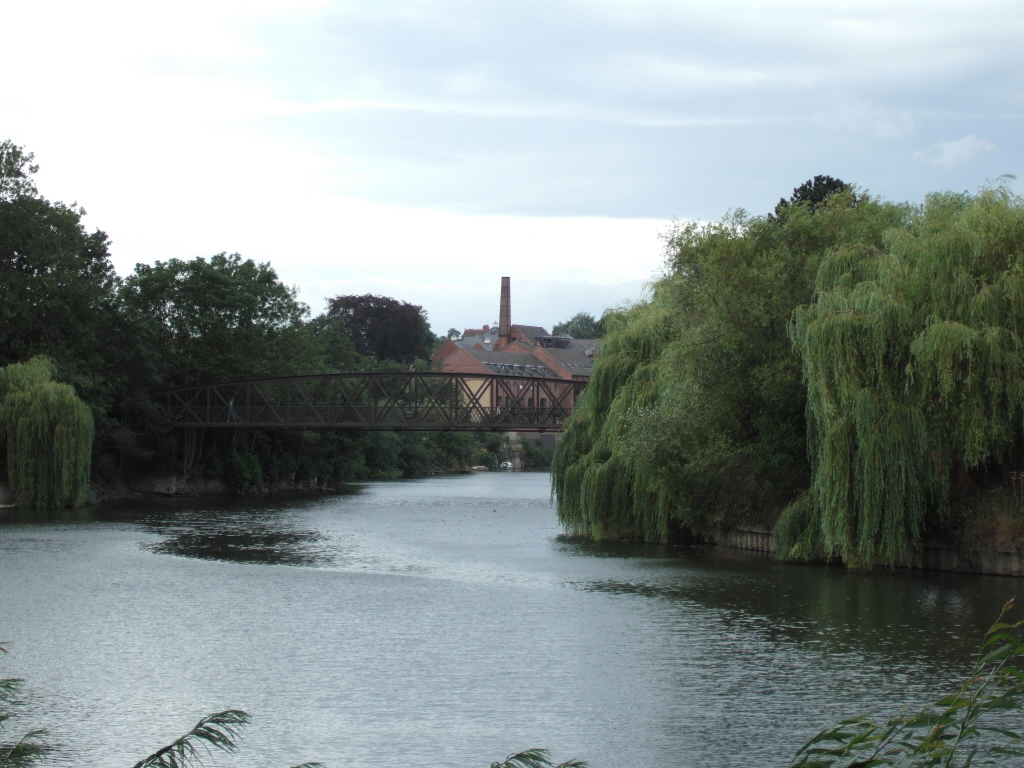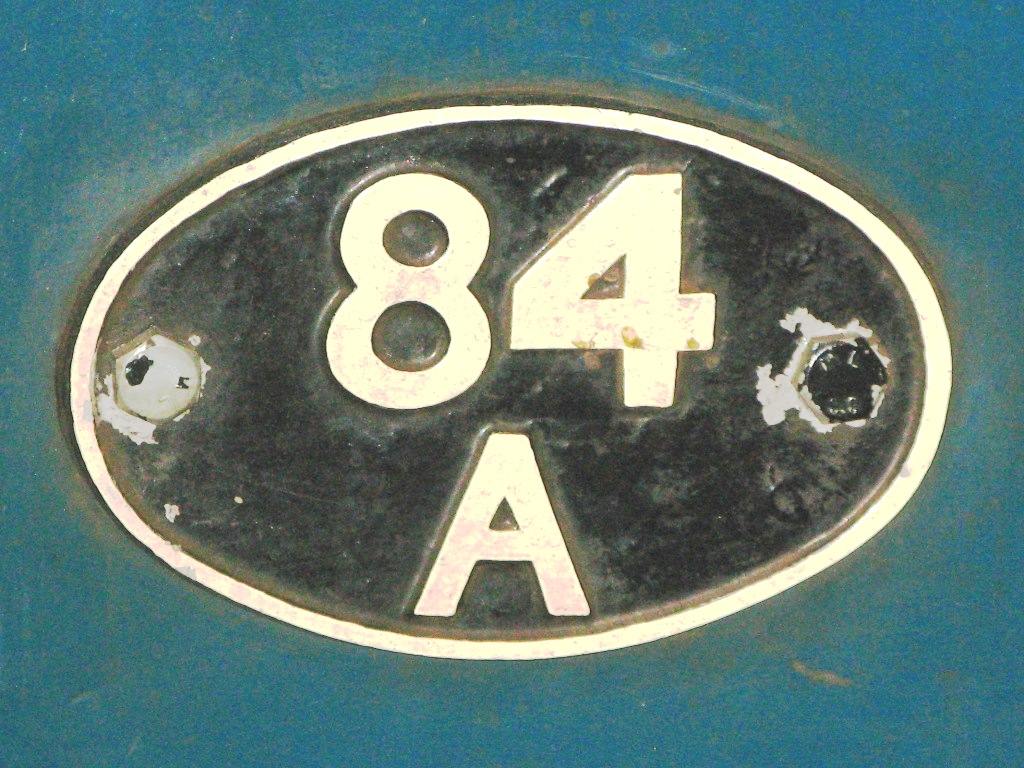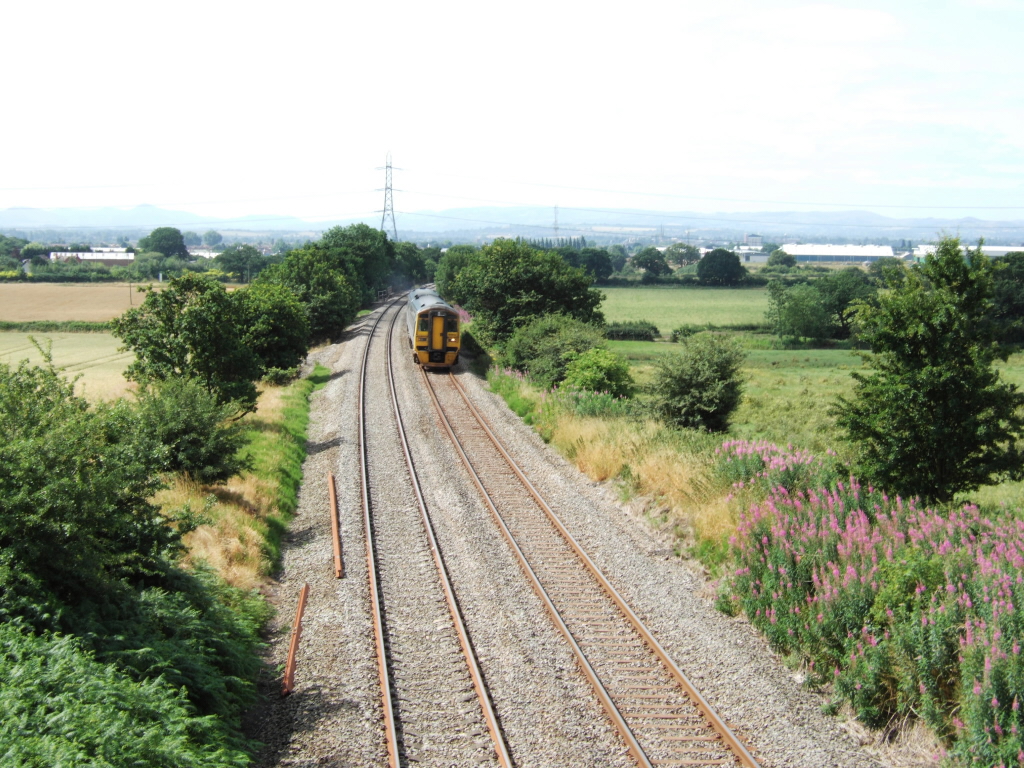|
Shrewsbury Traction Maintenance Depot
Shrewsbury TMD is a railway traction maintenance depot (TMD) situated in Coleham, Shrewsbury, England. The TMD forms part of Coleham Depot, a permanent way depot operated by Network Rail. The code for the TMD is 'SB'. Location The depot is situated at Sutton Bridge Junction, where the Cambrian Line connects with the Welsh Marches Line, approximately to the south of Shrewsbury railway station. The TMD was constructed in 2008 on the site of rarely used permanent way sidings - which had themselves been built on the site of the former extensive joint GWR/LNWR goods yard - as part of the ERTMS project on the Cambrian Line. The depot became the base for Network Rail British_Rail_Class_97#97301–97304, 97/3s (former British Rail Class 37, Class 37 locomotives) for ERTMS testing on the Cambrian Line. The locomotives arrived in 2009 (see the allocation section below). The new maintenance depot consists of a single-road inspection shed with an additional siding to one side to run round ... [...More Info...] [...Related Items...] OR: [Wikipedia] [Google] [Baidu] |
Coleham
Coleham is a district of the town of Shrewsbury in Shropshire, England. It is located just south, over the River Severn, from Shrewsbury town centre. History Coleham grew up as a village outside medieval Shrewsbury, with the nearest crossing over the Severn to the town being the Stone Bridge (now the English Bridge). Shrewsbury Abbey and its associated lands and buildings were nearby. The Rea Brook separates Coleham from the other old suburb on this end of town – Abbey Foregate. Coleham is centered on the Shrewsbury to Longden road, which as it passes through Coleham itself is called "Longden Coleham". The Victorian suburb of Belle Vue grew up south of Coleham and the wealthy suburb of Kingsland (which centres on Shrewsbury School) grew up west of Coleham. The first large scale industrial building in Shrewsbury arose in Coleham when in 1790 the firm of Powis & Hodge built three factory buildings on land bought from John Carline at the junction of Longden Coleham and Coleha ... [...More Info...] [...Related Items...] OR: [Wikipedia] [Google] [Baidu] |
British Rail Class 37
The British Rail Class 37 is a diesel-electric locomotive. Also known as the English Electric Type 3, the class was ordered as part of the British Rail modernisation plan. They were numbered in two series, D6600–D6608 and D6700–D6999. The Class 37 became a familiar sight on many parts of the British Rail network, in particular forming the main motive power for InterCity services in East Anglia and within Scotland. They also performed well on secondary and inter-regional services for many years. Many are still in use today on freight, maintenance, and empty stock movement duties. The Class 37s are known to some railway enthusiasts as " tractors", a nickname given due to the similarities between the sound of the Class 37's engine and that of a tractor. Description Background As part of the large scale dieselisation brought about by the British Rail modernisation plan a need was identified for a number of type 3 locomotives of power output to . English Electric had ... [...More Info...] [...Related Items...] OR: [Wikipedia] [Google] [Baidu] |
List Of British Railways Shed Codes
British Railways shed codes were used to identify the engine sheds that its locomotives and multiple units were allocated to for maintenance purposes. The former London, Midland and Scottish Railway (LMS) alpha-numeric system was extended to cover all regions and used until replaced by alphabetic codes in 1973. System of codes The coding system had its origins in a reorganisation of locomotive operation and maintenance on the LMS in the 1933-35 period. It grouped all sheds into districts with a main shed, given the district number followed by the letter A as its code, and subsidiary sheds with the same number followed by B, C, or D etc. Many sheds were also responsible for sub-sheds where day-to-day servicing could be carried out but which lacked the facilities for intermediate or heavy overhauls. The extension of the system to all regions was brought into use in 1950, each region being given a block of district numbers: * 1 – 28 London Midland Region * 30 – 41 Eastern Region ... [...More Info...] [...Related Items...] OR: [Wikipedia] [Google] [Baidu] |
Railways Of Shropshire
The English county of Shropshire has a fairly large railway network, with 19 National Rail stations on various national lines; there are also a small number of heritage and freight lines, including the famous heritage Severn Valley Railway running along its eastern border with Worcestershire. The majority of the county's public rail services are run by Transport for Wales Rail; the remainder are run by West Midlands Trains (under their ''West Midlands Railway'' brand) and Avanti West Coast. National Rail services National Rail services in Shropshire are centred about Shrewsbury station (all other 'national rail' stations in Shropshire have a direct train service to Shrewsbury, which is the county town), which is managed by Transport for Wales. The station is at the junction of the Wolverhampton to Shrewsbury Line, Shrewsbury to Chester Line, the Welsh Marches Line (between Cardiff and Manchester) and the Cambrian Line (towards Welshpool). Craven Arms station is at ... [...More Info...] [...Related Items...] OR: [Wikipedia] [Google] [Baidu] |
Railway Roundhouse
A railway roundhouse is a building with a circular or semicircular shape used by railways for servicing and storing locomotives. Traditionally, though not always the case today, these buildings surrounded or were adjacent to a turntable. Overview Early steam locomotives normally traveled forwards only. Although reverse operations capabilities were soon built into locomotive mechanisms, the controls were normally optimized for forward travel, and the locomotives often could not operate as well in reverse. Some passenger cars, such as observation cars, were also designed as late as the 1960s for operations in a particular direction. Turntables allowed locomotives or other rolling stock to be turned around for the return journey, and roundhouses, designed to radiate around the turntables, were built to service and store these locomotives. Most modern diesel and electric locomotives can run equally well in either direction, and many are push-pull trains with control cabs ... [...More Info...] [...Related Items...] OR: [Wikipedia] [Google] [Baidu] |
Great Western Railway
The Great Western Railway (GWR) was a British railway company that linked London with the southwest, west and West Midlands of England and most of Wales. It was founded in 1833, received its enabling Act of Parliament on 31 August 1835 and ran its first trains in 1838 with the initial route completed between London and Bristol in 1841. It was engineered by Isambard Kingdom Brunel, who chose a broad gauge of —later slightly widened to —but, from 1854, a series of amalgamations saw it also operate standard-gauge trains; the last broad-gauge services were operated in 1892. The GWR was the only company to keep its identity through the Railways Act 1921, which amalgamated it with the remaining independent railways within its territory, and it was finally merged at the end of 1947 when it was nationalised and became the Western Region of British Railways. The GWR was called by some "God's Wonderful Railway" and by others the "Great Way Round" but it was famed as the "Holi ... [...More Info...] [...Related Items...] OR: [Wikipedia] [Google] [Baidu] |
Shrewsbury And Hereford Railway
The Shrewsbury and Hereford Railway was an English railway company that built a standard gauge line between those places. It opened its main line in 1853. Its natural ally seemed to be the Great Western Railway. With other lines it formed a route between the mineral resources of South Wales and the industries of the north-west of England, and this attracted the interest of the London and North Western Railway, which sought access to South Wales. The GWR and the LNWR jointly leased the S&HR line in 1862, later jointly acquiring ownership of it, in 1871. LNWR mineral traffic developed, and after the opening of the Severn Tunnel in 1886, the line became an important main line for traffic from the south-west of England to the north-west. With the decline in local passenger and goods traffic in the 1950s many intermediate stations closed, but the main line continues in important use at the present day. Origins On 3 August 1846, 16 railway bills were passed in Parliament; one of these ... [...More Info...] [...Related Items...] OR: [Wikipedia] [Google] [Baidu] |
West Midlands Trains
West Midlands Trains (WMT) is a train operating company in the United Kingdom. It operates passenger trains on the West Midlands franchise between London and the English Midlands under two trade names: West Midlands Railway (WMR) (within the West Midlands region) and London Northwestern Railway (LNR) (outside the region). West Midlands Trains was created as a consortium of three companies, Abellio, JR East, and Mitsui & Co., which joined to bid for the West Midlands franchise; they were amongst the three bids to be shortlisted in April 2016, and were awarded the franchise during August 2017. In addition to the DfT, it is also accountable to the West Midlands Rail Executive for services that operate wholly within the West Midlands region. On 10 December 2017, West Midlands Trains took over operations from the prior operator, London Midland. As per the original terms of the franchise, West Midlands Trains is expected to continue to operate it until March 2026. During October ... [...More Info...] [...Related Items...] OR: [Wikipedia] [Google] [Baidu] |
Transport For Wales Rail
Transport for Wales Rail Limited, branded as Transport for Wales and TfW Rail ( and ), is a Welsh publicly owned train operating company, a subsidiary of Transport for Wales (TfW), a Welsh Government-owned company. It commenced operations of the day to day services of the Wales & Borders franchise on 7 February 2021, as an operator of last resort, succeeding KeolisAmey Wales. Transport for Wales Rail manages 248 National Rail stations, including all 223 in Wales, and operates all passenger mainline services wholly within Wales, and services from Wales, Chester, and Shrewsbury to Liverpool, Manchester, Manchester Airport, Crewe, Birmingham, Bidston and Cheltenham. History In May 2018, the Wales & Borders franchise was awarded by Transport for Wales to KeolisAmey Wales. Scheduled to run for 15 years, it commenced in October 2018. Following a collapse in revenues, and a significant reduction in passenger numbers as a result of the COVID-19 pandemic, the original franchise h ... [...More Info...] [...Related Items...] OR: [Wikipedia] [Google] [Baidu] |
Diesel Multiple Unit
A diesel multiple unit or DMU is a multiple-unit train powered by on-board diesel engines. A DMU requires no separate locomotive, as the engines are incorporated into one or more of the carriages. Diesel-powered single-unit railcars are also generally classed as DMUs. Diesel-powered units may be further classified by their transmission type: diesel–mechanical DMMU, diesel–hydraulic DHMU, or diesel–electric DEMU. Design The diesel engine may be located above the frame in an engine bay or under the floor. Driving controls can be at both ends, on one end, or in a separate car. Types by transmission DMUs are usually classified by the method of transmitting motive power to their wheels. Diesel–mechanical In a diesel–mechanical multiple unit (DMMU), the rotating energy of the engine is transmitted via a gearbox and driveshaft directly to the wheels of the train, like a car. The transmissions can be shifted manually by the driver, as in the great majority of first-gene ... [...More Info...] [...Related Items...] OR: [Wikipedia] [Google] [Baidu] |
Stabling Point
In the UK, a stabling point is a place where rail locomotives are parked while awaiting their next turn of duty. A stabling point may be fitted with a fuelling point and other minor maintenance facilities. A good example of this was Newport's Godfrey Road stabling point, which has since been closed. Stabling sidings can be just a few roads or large complexes like Feltham Sidings. They are sometimes electrified with a third rail or OLE. An example of a stabling point with third rail would be Feltham marshalling yard Feltham marshalling yard, also known as Feltham hump yard, was a large railway marshalling yard designed for the concentration of freight traffic to and from South West London, and for transfer to other marshalling yards in London. It was built ... which is being made into carriage sidings for the British Rail Class 701 EMU. References Stabling point {{UK-rail-transport-stub ... [...More Info...] [...Related Items...] OR: [Wikipedia] [Google] [Baidu] |
Severn Bridge Junction
Severn Bridge Junction is the area of railway lines just south east of Shrewsbury railway station, in Shropshire, England. It is controlled by a mechanical interlocked signal box of the same name, which is the largest operational mechanical signal box in the world.Network Rail Refurb of World's largest working mechanical signal box completes The signalling area code is 'SBJ.' Background The complexity of the railway system in the area is brought about by the convergence of five major lines at , built in the[...More Info...] [...Related Items...] OR: [Wikipedia] [Google] [Baidu] |









